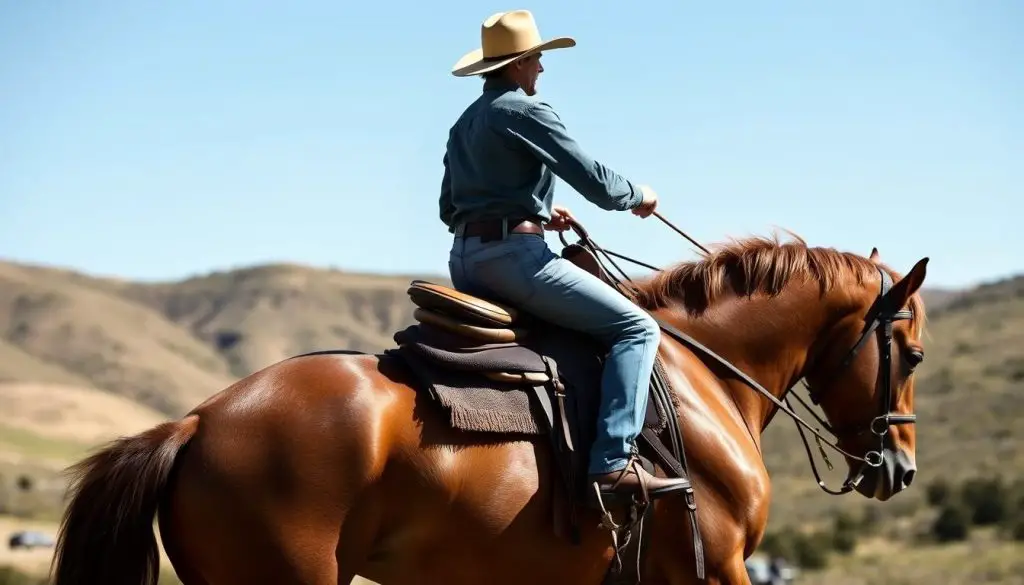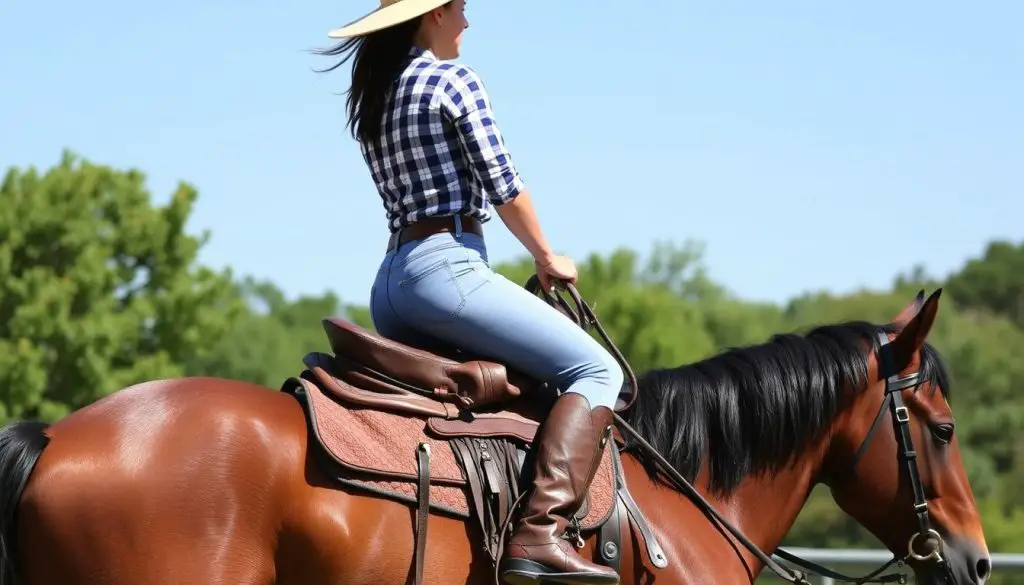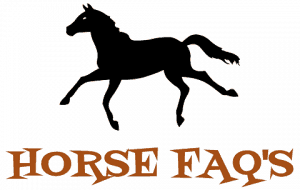Have you ever wondered how mastering your balanced seat can transform both your riding experience and your horse’s performance? Understanding the intricacies of balance in Western riding not only enhances your equitation but also nurtures a more harmonious horse rider relationship. This article will guide you through essential strategies to develop a balanced seat, ensuring proper alignment, weight distribution, and overall control while riding.
Key Takeaways
- A 90-degree leg angle is essential for maintaining balance over the pommel in Western riding.
- Stirrup positioning should enable the foot to align with the knee, tailored to the horse’s barrel size.
- Rider’s center of gravity must align with the horse’s for optimal balance and control.
- Regular practice, such as lunging, helps cultivate a deep and relaxed seat.
- Core strength and pelvic stabilization are critical in achieving a balanced seat.
- Even weight distribution during different gaits is vital for supporting the horse’s balance.
- Correct hand position and relaxed posture enhance the effectiveness of your aids.
Importance of a Balanced Seat in Western Riding
A balanced seat significantly enhances both the horse’s performance and the rider’s control, establishing a crucial foundation in Western riding. The relationship between rider and horse flourishes when the rider maintains proper alignment, leading to improved communication and harmony during equine locomotion.
Impact on Horse Performance
The balanced seat importance is evident in how it impacts the horse’s ability to maintain a balanced frame while performing various gaits. Horses thrive when ridden by individuals who possess a stable and well-aligned posture, as this allows for smooth transitions and better maneuverability. When the rider is positioned correctly, the horse can more effectively engage its core and legs, resulting in enhanced performance.
Benefits for Rider Control
Maintaining a balanced seat offers substantial benefits for rider control. A rider’s ability to issue precise cues is amplified when they achieve a secure position in the saddle. This connection fosters improved horse communication, as the rider can better influence the horse’s movements and reactions. Strengthening this partnership leads to greater confidence for both horse and rider, allowing them to tackle a range of riding challenges safely and enjoyably.
| Aspects | Balanced Seat Impact | Consequences of Imbalance |
|---|---|---|
| Horse Performance | Improves movement quality and responsiveness | Hinders performance and can lead to injury |
| Rider Control | Enhances precision in cues and commands | Reduces effectiveness of communication with the horse |
| Safety | Increases stability and confidence | Increases the risk of falls and accidents |
In summary, the importance of a balanced seat in Western riding cannot be overstated. A stable seat leads to improved horse performance, better rider control, and ultimately a more enjoyable riding experience for both parties involved.
How to Develop a Balanced Seat in Western Riding
Developing a balanced seat is essential for any western rider, as it not only enhances control over the horse but also significantly impacts the horse’s performance. Understanding the key components of balance is the first step towards achieving rider goals in equestrian training.
Key Components of Balance
When working towards developing a balanced seat, attention should be paid to proper alignment. Riders should focus on achieving a vertical alignment where their ears are over their shoulders, shoulders over their hips, and hips over their heels. This alignment suspends the rider over the center of the horse’s motion, allowing for optimal communication and weight distribution.
- Maintaining soft and engaged core muscles provides stability.
- Effective use of legs ensures proper weight distribution in the saddle.
- Establishing a longer leg position improves balance and control.
Setting Goals for Improvement
Setting specific rider goals is crucial in guiding your equestrian training. By identifying areas for improvement, such as weight distribution or leg placement, riders can focus their efforts and track progress over time. Incorporating feedback from experienced peers or coaches can enhance learning, making it easier to refine skills necessary for developing a balanced seat.
| Component | Description | Impact on Riding |
|---|---|---|
| Alignment | Ensuring ears, shoulders, hips, and heels are in line | Enhances balance and communication with the horse |
| Core Engagement | Utilizing stomach muscles for stability | Improves overall control and endurance |
| Leg Position | Ball of the foot in stirrup, heel lower than toe | Supports proper balance and helps transmit signals |

Understanding Proper Leg Position
Achieving the right proper leg position is essential for developing a balanced seat in Western saddle riding. Properly aligning your legs not only aids in stability but also directly influences your communication with the horse. This section delves into significant factors like leg angles and saddle fit, as well as the importance of keeping your heels down for an optimal riding experience.
Leg Angles and Saddle Fit
The positions of your legs while riding play a considerable role in overall comfort and performance. A 90-degree angle is generally ideal for effective saddle fit. When your legs rest at this angle, it allows your body weight to distribute evenly, enhancing balance. On the contrary, improper leg angles can lead to discomfort, which many riders experience. Research indicates that 60% of riders face stirrup retention issues while cantering, often due to poor leg positioning.
Maintaining Heels Down
Additionally, maintaining your heels down provides the stability needed to stay centered in the saddle. This position prevents excessive weight from shifting onto the horse’s back, promoting smoother movement and reducing the risk of instability. Many riders struggle with this concept; statistics reveal that 70% have difficulty ensuring their heels are down appropriately. Remember that it takes continuous practice and awareness to develop this habit, particularly in transitions or turns where balance can be affected.
Understanding and applying proper leg position elements enhances your skills as a rider. For those interested in more insights on maintaining a balanced seat, follow this guide that provides valuable tips and techniques.
The Role of Pelvic Alignment
Pelvic alignment serves as a cornerstone for achieving a balanced seat in Western riding. When the pelvis is aligned correctly, it enables riders to sit squarely in the saddle, promoting better overall body position and rider balance. Understanding how to maintain a correct pelvic position is crucial for maximizing riding efficiency and enhancing communication with the horse.
How to Achieve Correct Pelvic Position
To establish a correct pelvic position, riders should focus on achieving a neutral pelvic alignment. This involves recognizing the three main pelvic bones: the sacrum at the back, the two seat bones (ischia) at the bottom, and the hip bones (illia) on each side. Beginner riders can start by assessing their pelvic tilt. Here are steps to find the neutral position:
- Lie on your back with your knees bent.
- Gently roll the pelvis between anterior and posterior tilts.
- Identify the point where your pelvis feels stable with a slight natural curve in the lower back.
- Practice finding this alignment while riding, noting any changes during various gaits.
This awareness can prevent issues caused by exaggerated pelvic tilts, such as rounding the back or developing a “fork seat.” When the pelvis is stacked correctly and weight is evenly distributed across the seat bones, it allows for free movement of the hips, promoting smoother transitions and better control of the horse.
Effects on Overall Balance
The impact of pelvic alignment on overall rider balance cannot be overstated. Correct alignment aids in distributing weight evenly across the seat bones and glutes, making the load more comfortable for both the rider and the horse. When a rider’s pelvis is aligned correctly, it stabilizes the core and contributes to improved posture.
Inconsistent alignment can lead to pain, injuries, and decreased performance. Riders must pay attention to their body’s tendencies, seeking symmetry in muscle strength and flexibility. Addressing any imbalances will enhance the ability to sit evenly on both seat bones, essential for effective western riding techniques. Recognizing how to achieve and maintain optimal pelvic alignment fosters a deeper connection between the rider and the horse.

| Pelvic Tilt Type | Characteristics | Rider Impact |
|---|---|---|
| Anteror Pelvic Tilt | Pelvis tilts towards the front, hollowing the back. | Can lead to a “fork seat” and instability. |
| Posterior Pelvic Tilt | Pelvis tilts towards the back, rounding the back. | May hinder movement, affecting rider balance. |
| Neutral Pelvic Alignment | Even distribution of weight across seat bones. | Enhances overall balance and stability while riding. |
Core Engagement for Stability
Core engagement plays a pivotal role in achieving stability while riding. A strong core not only enhances your posture but also facilitates fluid reactions to your horse’s movements. Riders can significantly benefit from focused strength training and stability exercises targeting core muscles. This section explores exercises that strengthen these essential muscles and emphasizes their importance in maintaining balance during riding.
Exercises to Strengthen Core Muscles
Several exercises can effectively boost core muscle strength, contributing to improved riding stability. Incorporating the following exercises into a regular workout routine promotes greater control and endurance in the saddle:
- Planks: Engaging multiple muscle groups, planks enhance overall core stability.
- Back Extensions: Strengthen the lower back and improve postural alignment.
- Core Rotations: Enhance balance and coordination, essential for adopting various riding positions.
- Equicise: Simulate riding experiences with sensors that monitor balance and grip, providing real-time feedback.
Importance of Core during Riding
The significance of core engagement during riding cannot be overstated. Maintaining a stable core allows riders to achieve a balanced position without excessive tension in the legs or hands. A well-engaged core promotes a gentle hand-to-mouth connection with the horse, creating a more harmonious experience for both rider and animal. Additionally, improved stability aids riders in performing tasks such as sitting trot and executing transitions smoothly.
| Exercise | Benefits |
|---|---|
| Planks | Improves core stability and strength. |
| Back Extensions | Enhances lower back support and posture. |
| Core Rotations | Boosts coordination and balance. |
| Equicise | Offers real-time feedback for better balance. |
Weight Distribution Techniques
Mastering weight distribution is essential for riders aiming to enhance their balance in motion. When riding, effective techniques can dramatically improve performance and communication with the horse. Focused attention on weight distribution allows for fluid movement and interaction with the horse, contributing to a harmonious riding experience.
Equal Weight on Seat Bones
To achieve a balanced seat, riders must strive for equal weight on both seat bones. This technique promotes stability and reduces unnecessary strain on the horse’s back. Proper weight distribution on the seat bones facilitates smoother transitions between gaits, improving overall riding techniques. A well-balanced rider also helps the horse maintain quality gaits and smooth movements.
Adjusting Weight for Different Gaits
Different gaits require specific adaptations in weight distribution. Riders should be aware of how subtle shifts in weight can influence their horse’s movements. For example, during a walk or trot, distributing weight evenly across both seat bones supports the horse’s natural rhythm. As the horse transitions into a lope, shifting weight slightly back may enhance balance and control. Practicing these adjustments allows for better responsiveness and a more connected ride.
| Gait | Weight Distribution Technique | Purpose |
|---|---|---|
| Walk | Even weight on seat bones | Maintains horse’s rhythm |
| Trot | Equal pressure on legs and seat | Enhances stability and control |
| Lope | Weight slightly towards the back | Supports balance and smooth transitions |
Incorporating these techniques into regular riding practice helps develop a rider’s awareness and understanding of how weight affects the overall performance. Engaging with the horse becomes smoother as riders fine-tune their riding techniques based on specific gaits.
Balance Exercises to Practice
Balancing during riding requires dedication and the right practice strategies. Riders can significantly enhance their skills through a combination of balance exercises performed both on and off the horse. Integrating various techniques helps develop a deeper understanding of body movement and stability, critical for effective rider training and balance improvement.
Exercises for Riders Off the Horse
Engaging in off-horse practice provides an excellent opportunity to focus on core strength and overall fitness, essential for maintaining balance while riding. Consider incorporating exercises such as:
- Yoga and Pilates: These practices enhance flexibility and core strength, both vital for a stable riding position.
- Imaginary Beach Ball Exercise: This exercise promotes good upper body posture and core stability, which translates to better balance when mounted.
- Juggling: It develops independent hand functions, improving multitasking while riding.
- Bicycle Exercise: This movement loosens the hip flexors and lower back, vital for achieving a deep seat.
- Arm Circles: Practicing this can enhance balance and coordination.
- Hand Stabilizing Exercise: Holding a crop horizontally helps quiet the hands, which is important for maintaining a steady position.
On-Horse Drills for Balance Improvement
On-horse drills are crucial for applying balance exercises practically. They enhance the rider’s ability to maintain a balanced seat in dynamic situations. Effective riding drills include:
- Posting Exercise Variations: These exercises improve balance by alternating between posting and sitting during the trot.
- Circling: Riding circles requires proper positioning, which fosters correct bend and helps prevent leaning.
- Slow Posting: This technique encourages more control over body weight distribution, aiding in maintaining balance.
- Upper Body Relaxation Drills: These drills teach riders to stay loose and balanced, particularly when transitioning gaits.
- Standing in the Saddle: This exercise builds muscle strength and endurance crucial for effective weight transfer.
Incorporating these balance exercises helps riders develop their skills and supports their horses’ performance by ensuring smooth transitions and maintaining quality gaits. Regular practice of both off-horse and on-horse exercises fosters a deeper connection between the rider and the horse, ultimately enhancing the overall riding experience.
Seeking Experienced Coaching
Finding the right coach can elevate your Western riding skills significantly. Experienced coaching provides invaluable support, offering the professional riding guidance necessary to fine-tune your technique and develop a more balanced seat. This enhancement directly impacts your overall performance and connection with your horse.
The Value of Professional Guidance
Working with a coach who specializes in riding lessons allows for personalized feedback tailored to your unique strengths and weaknesses. Their insights can help you understand nuances of your riding posture, including the importance of sitting deep in the saddle and maintaining relaxed shoulders. Coaches teach essential skills such as anticipating the horse’s movements and providing timely cues for smooth transitions, fostering a strong partnership between you and your horse.
Tips for Finding the Right Coach
When finding a coach, consider the following factors:
- Experience: Look for a coach with substantial experience in Western riding and a successful track record of improving riders.
- Teaching Style: Ensure their method aligns with your learning preferences, whether you thrive on structured lesson planning or flexible approaches.
- Constructive Feedback: A supportive learning environment is key; choose a coach who offers constructive criticism to help you improve while boosting your confidence.
Engaging in riding clinics or group lessons can also enhance your search. Observing different coaching styles can help you appreciate what resonates with you before committing. Remember, finding a coach is a journey in itself that should align with your goals of mastering a balanced seat.
Conclusion
Mastering a balanced seat in Western riding is essential for both equestrian improvement and enhancing riding performance. As outlined throughout this article, key components such as leg positioning, pelvic alignment, core engagement, and effective weight distribution techniques lay the groundwork for better rider-horse communication. Developing these skills allows riders to employ subtle seat cues, fostering a deep, non-verbal connection with their horses.
For riders eager to achieve a harmonious riding experience, it is crucial to engage in continuous practice and consider lessons from experienced professionals, such as those available at Ocean View Stables. Here, riders can learn to fine-tune their balance and become proficient in regulating speed and executing movements with ease, using primarily their seat. The beauty of Western riding lies not only in the technical aspects but also in the relationship built between horse and rider through understanding and mastery of these cues.
Ultimately, the journey toward a balanced seat is a rewarding one, filled with opportunities for growth and refinement. Whether on the trail or in the arena, the commitment to this pursuit will lead to significant improvements in riding performance and a fulfilling partnership with your horse. Remember, the key takeaways are that balance and consistent practice pave the way for a successful equestrian experience.
